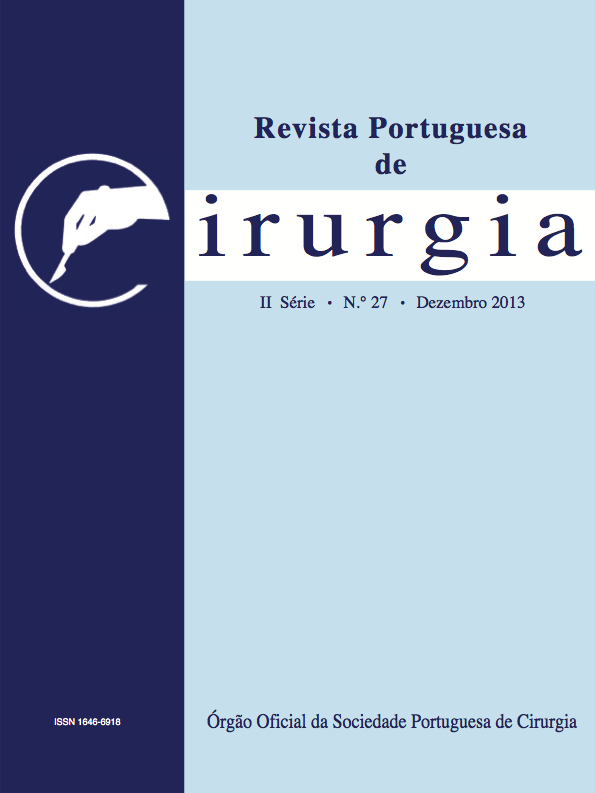Diabetic foot with acute infection: treatment in the Portuguese Emergency Department
Abstract
Diabetic foot is a common major complication of Diabetes mellitus. The general surgeon is responsible for its diagnosis and treatment. Acute infection is a medical and surgical emergency. This article aims to guide the surgeon in the diagnosis and treatment of infected diabetic foot in the emergency department. Broad-spectrum antibiotics, surgical drainage/debridement in the emergency department, inpatient, lying of the member and appropriate dressings are essential for the proper treatment of the diabetic foot with moderate-severe infection. The debridement should preserve the structure and function of the foot. Early intervention is essential in order to reduce the number of major amputations and mortality and social cost associated.
Keywords: diabetic foot, diabetic foot ulcer, acute infection ulcer, isquemic foot, neuropathic foot.
Downloads
References
Gardete Correia L, Luís Boavida JM, Fragoso de Almeida JP, et al. Diabetes: Factos e Números 2012 – Relatório Anual do Observatório Nacional da Diabetes (http://www.portugal.gov.pt/media/871173/20130219_relatorioanualdiabetes_2012.pdf, acesso em 15/06/2013)
International Consensus on the Diabetic Foot, Practical Guidelines on the Management and Prevention of the Diabetic Foot 2011 – PRE- VENT AMPUTATION
Shaw JE, Sicree RA, Zimmer PZ. Global estimates of the prevalence of diabetes for 2010 and 2030. Diabetes Res Clin Pract 2010; 87(1):4-14
Rafehi H, El-Osta A, Karagiannis T. Epigenetic mechanisms in the pathogenesis of diabetic foot ulcers. J Diabetes Complications
;26(6):554-61
Gupta S, Panda S, Singh S. The etiopathogenesis of the diabetic foot: an unrelenting epidemic Int J Low Extrem Wounds. 2010;1(3):127-31
Lipsky BA. Infectious Problems of the Foot in Diabetic Patients. In Levin and O’Neal’s, The diabetic foot. 7th ed. Philadelphia, Mosby 2008
Lipsky BA, Berendt AR, Cornia PB, et al. Infectious Diseases Society of America clinical practice guideline for the diagnosis and treatment of diabetic foot infections. Clin Infect Dis 2012;54(12):132-73
Armstrong DG, Wrobel JS, Robins MJ. Are diabetes-related wounds and amputations worse than cancer? Int Wound J 2007;(4):286-7
Mendes J, Marques-Costa A, Neves J, et al. Clinical and bacteriological survey of diabetic foot infections in Lisbon. Diabetes Res Clin Pract 2012;15(1):153-61
Cabete J, Moniz L, Pinto M, et al. Caracterização do Perfil microbiológico e de Sensibilidade antimicrobiana dos microrganismos isolados em úlceras diabéticas de doentes de um hospital português. Rev Portuguesa Cirurgia Cardio-Torácica e Vascular 2011;18(1):53-60
Moues CM, Vos MC, van den Bemd GJ, et al. Bacterial load in relation to vacuum-assisted closure wound therapy: a prospective randomized trial. Wound Repair Regen 2004;(12):11-7
Weed T, Ratliff C, Drake DB. Quantifying bacterial bioburden during negative pressure wound therapy: does the wound VAC enhance
bacterial clearance? Ann Plast Surg 2004(52):276-9
Armstrong, D. Andros G. Use of negative pressure wound therapy to help facilitate limb preservation. Int Wound J 2012; 1 (Suppl. 1):1-7
Lavery LA, Armstrong DG, Peters EJ, et al. Probe-to-bone test for diagnosing diabetic foot osteomyelitis: reliable or relic? Diabetes Care 2007;30:270
Mendes JJ, Neves J. Diabetic Foot Infections: Current Diagnosis and Treatment. The Journal of Diabetic Foot Complications 2012;
(2):26-45
Coelho J, Clerigué A, Neves J, et al. Análise retrospectiva do protocolo de tratamento utilizado na Consulta Multidisciplinar de Úlcera de Perna do Hospital dos Capuchos no período entre 2002 e 1o semestre 2006. Rev Portuguesa Cirurgia 2008;5:19-24
Downloads
Published
Issue
Section
License
Para permitir ao editor a disseminação do trabalho do(s) autor(es) na sua máxima extensão, o(s) autor(es) deverá(ão) assinar uma Declaração de Cedência dos Direitos de Propriedade (Copyright). O acordo de transferência, (Transfer Agreement), transfere a propriedade do artigo do(s) autor(es) para a Sociedade Portuguesa de Cirurgia.
Se o artigo contiver extractos (incluindo ilustrações) de, ou for baseado no todo ou em parte em outros trabalhos com copyright (incluindo, para evitar dúvidas, material de fontes online ou de intranet), o(s) autor(es) tem(êm) de obter, dos proprietários dos respectivos copyrights, autorização escrita para reprodução desses extractos do(s) artigo(s) em todos os territórios e edições e em todos os meios de expressão e línguas. Todas os formulários de autorização devem ser fornecidos aos editores quando da entrega do artigo.



